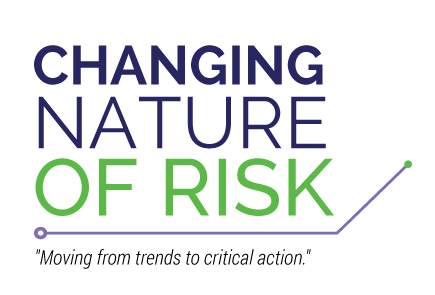Industry Maturity Index: 'Now '
Why this is important: The ACT Changing Nature of Risk workgroup expects that 3D Printing will become more commonplace as price points reduce for the technology and as other industries embrace its usage. Industries such as Manufacturing and Healthcare are already using 3D printing for prototyping and more. The legal implications as far as product liability are still vague as the technology is just now becoming more mainstream especially for personal/home use. Yet, this technology is going to significantly change product design, development and manufacturing as we know it. It is very much an enabler to the gig economy.
What is it?
3D printing, also known as additive manufacturing (AM), are processes used to synthesize a three-dimensional object[1] in which successive layers of material are formed under computer control to create the object.[2] These objects can be of almost any shape or geometry and are produced from digital model data 3D model or other electronic data source such as an Additive Manufacturing File (AMF) file. - Wikipedia
TED Fellow Skylar Tibbits is shaping the next development, which he calls 4D printing, where the fourth dimension is time. This emerging technology will allow us to print objects that then reshape themselves or self-assemble over time. https://www.ted.com/talks/skylar_tibbits_the_emergence_of_4d_printing?language=en
Broad Implications / Uses:
This has applications across many spectrums of our lives;
● 3D printing is democratizing manufacturing, and will soon change the way all product-based companies do business.
● Almost anyone will be able to become a “boutique” manufacturer.
● As it’s not regulated, anyone can buy a 3-d printer and produce items that could have broad negative impact - such as weapons, as well as, positive impact as enabling just in time parts
● Copyright and trademark infringement - as 3-D printing can replicate items quite easily
● Positive impact in the medical field - for instance - prosthetics, join replacement
● Product liability (printer itself, Material used in printing, intellectual property/software) - can it go back to the manufacturers of the 3-D printers? How will 3D printed aftermarket parts impact product liability?
● Impact on inventory - just in time products and parts.
● Automotive and aerospace
● Construction and engineering
● Food
● Home use
As both the variety of 3D Printers and materials become more widely available, the applications to reduce time, workforce to assemble, and end-user cost will drive 3D Printing to be used in almost every aspect of our society.
Economic Impact(s): ● Dramatically reduce product development, prototype and spec work time - which will seriously disrupt the traditional processes and make some smaller manufacturers and engineers who did this work dinosaurs.
● Disrupt product distribution
● Reduce labor cost and production costs for many items we now use - in turn it will also put some manufacturers and laborers out of work as the technology broadens.
● Possible reduction of imports if American manufacturers can produce products locally and be cost efficient
● Possible increase in black market items - forgeries etc.
● Retail outlets that formerly sold mass-produced products will vanish, just like camera stores vanished when photography went digital.”
● Facilitates or enables Gig/Freelance economy.
Insurance Industry Implications: 3D Printing can have positive and negative impacts to many areas of our industry;
● Positive Impacts o Increased risk opportunities - premium due to new businesses and new exposures
o As companies become more technical - the need to have a solid risk manager on their team will increase
o Large changes in the Underwriting
o Actuarial disciplines
o Generating just-in-time repair parts for auto & home
o Claims processes for policyholders to repair/replace their own broken or failed automobile or home equipment.
o integrations for carriers & vendors to connect to home 3D Printers to automatically generate repair parts after diagnostics.
● Negative Impacts o E&O issues as agents, carriers figure out how to best advise clients on insurance coverage and processes for safety, R&D and product quality
o Agents need to learn the right questions to ask when working with new and current clients
Recommended Actions: Agents - Ensure you and staff are aware of the basic 3D Printing concepts and applications (see ‘Resources’)
Review your current customer base for possible impacts
Review standard market policies to determine coverage or coverage gaps.
Carriers - Investigate offering coverages across spectrum of impact.
Underwriting implications – who is using the printer? Warranty issues.
Vendors - Ensure management, quoting, and contact systems have the ability to handle these as specialty products.
Examples/Resources: http://www.techrepublic.com/pictures/ten-glimpses-into-the-future-of-3d-printing/ http://www.mckinsey.com/business-functions/operations/our-insights/3-d-printing-takes-shape http://www.wired.com/2016/05/hp-wants-give-3-d-printing-inkjet-moment/ https://www.youtube.com/watch?v=THRjdYpnZvU http://cgd.swissre.com/risk_dialogue_magazine/3D_printing/How_3D_printing_will_reshape_the_inurance_landscape.htmlEvolving Technology Caution:Detail the challenges with each topic – ex, aspects such as liability for hacking, impacts of possible system or sensor failure, issues if power outage (as in Smart Homes). Also ensure readers are counseled that while the evolution of technology empowers, it also has a myriad of challenges to be aware of as fully as possible.
Call to Action:● Insurance Industry needs to be very clear about potential product liability issues, warranty issues - so we can properly communicate that to any of our clients who are using 3D printing in their business
● Small Businesses - do we potentially need a 3-D printing BOP or specific coverage to cover this? Carriers should take note.
● Personal usage of 3D Printing technology has increased - how does this affect homeowner’s insurance – specifically for Liability? Insurance agents need to learn how to ask more in depth questions about personal property and home based business ventures to ensure E&O compliance.
Authors: Cindy Donaldson, Rick Morgan
To download a PDF of this Risk Advisory:  ACT Risk Advisory - 3D Printing - 2017Feb15.docx
ACT Risk Advisory - 3D Printing - 2017Feb15.docx